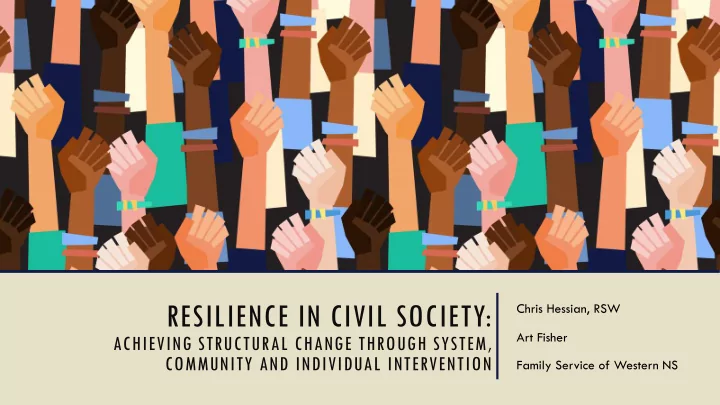

RESILIENCE IN CIVIL SOCIETY: Chris Hessian, RSW Art Fisher ACHIEVING STRUCTURAL CHANGE THROUGH SYSTEM, COMMUNITY AND INDIVIDUAL INTERVENTION Family Service of Western NS
CANADA
NOVA SCOTIA BRIDGEWATER
FAMILY SERVICE OF WESTERN NOVA SCOTIA FREEMAN HOUSE BRIDGEWATER, NS
LEARNING OBJECTIVES Ø Explore civil society’s abdication of responsibility for structural violence Ø Transform individual therapeutic intervention and challenge the concept of ethical accountability Ø Engage the informal end of the restorative continuum to prevent violence at the individual, community and system level through community collaboration Ø Explore methods for achieving Collaborative Coordinated Access that fosters accountability and restores relationships Ø Outline strategies that will address barriers to achieving collective impact through community collaboration
“The concept of personhood that figures most prominently in contemporary Western ethical and political theory is that of the independent, rational, self- aware, self-reliant, self-interested individual thoroughly (if not obsessively) engaged in the autonomous pursuit of his interests ” (Baylis, 2012, p. 112)
“ ” RELATIONAL THEORY No one is fully independent... the view of individuals as isolated social units is not only false but impoverished: much of who we are and what we value is rooted in our relationships and affinities with others... all persons are, to a significant degree, socially constructed... their identities, values, concepts, and perceptions are, in large measure, products of their social environment (Sherwin, 1998, p. 34)
DIRECT VIOLENCE LOOKING FOR THE UNEXPECTED FABULOUSNESS WITHIN EACH OF US VISIBLE INVISIBLE STRUCTURAL VIOLENCE COMMUNITY VIOLENCE (Galtung, 1990)
LOW HIGH TO WITH Punitive Restorative FAIR + Authoritarian Authoritative EXPLICIT CONTROL PRACTICE NOT FOR Neglectful Permissive Irresponsible Paternalistic LOW HIGH (Wachtel, 2016, p. 3) SUPPORT
Restorative Continuum Informal Formal Impromptu Im Restor Re orative Convos/ Co Formal Fo Ci Circles Languag Lan age Re Restor orative Conference Co Questions Qu Making, Developing and Maintaining Relationships Repairing Harm Proactive Responsive (Wachtel, 2016, p. 4)
RESTORATIVE APPROACHES Ø As a community we embrace person-centered practice, meeting our clients where they are at, working with and supporting them as they navigate challenges and successes in their lives Ø If we embrace Restorative Practices in our social structures and community based work it will allow us to: ‣ Challenge ourselves to alter the way we think about relationships and community development ‣ Utilize integrative ways to practice that compliment traditional approaches and practices, giving voice and encouraging accountability through reflection ‣ Develop capacity in communities and institutions to achieve prevention (Fraser & Seymour, 2017)
INDIVIDUAL LEVEL Families Individuals Children
Community COMMUNITY LEVEL INDIVIDUAL LEVEL Families Individuals Children Partners
Government GOVERNMENT LEVEL Community COMMUNITY LEVEL INDIVIDUAL LEVEL Families Individuals Children Partners
Government GOVERNMENT LEVEL * COMMUNITY HUB Community COMMUNITY LEVEL INDIVIDUAL LEVEL Families Individuals Children * COORDINATED ACCESS Partners
Government GOVERNMENT LEVEL Worker-Centered Person-Centered Community COMMUNITY LEVEL Input Focused INDIVIDUAL LEVEL Outcome-Focused Discipline Driven Families Inquiry Driven Individuals Children Complex Case Complex Approach Competitive Collaborative Partners Turf to Defend Turf as Community
N O I T A R O B A L L O C Housing Y T I Income N Sexuality Gender U M M Education & Literacy O Culture Diversity C * Childhood Experiences Employment Work Conditions Health Behaviours Biology/Genetic Endowment Access to Services Inclusion Physical Environment Food Security (Gill & Theriault, 2005)
THE IMPORTANCE OF RELATIONSHIPS ‣ Encourages folks to have increased comfort and ownership during difficult conversations and provides the level of trust that is necessary for open and honest communication ‣ Hanging in there with those we have the privilege of working with, our community partners and the systems we all work within to achieve violence prevention
INTEGRATING RESTORATIVE PRACTICES Restorative Practice Check List q Practice is Explicit q Practice is Fair q Focus on Repairing Harm and Building/Restoring Relationships q Fosters Empathy, Responsibility and Accountability q Promotes the Likelihood of Positive Behavioural Change (Wachtel, 1999)
ACHIEVING COLLECTIVE IMPACT : ADDRESSING BARRIERS Ø What is Ultimately Required? Ø Collective Critical Reflection Ø Silence the Attack
Q & A
SELECT BIBLIOGRAPHY Afifi, T., McTavish, J., Turner, S., MacMillan, H., & Wathen, N. (2018). The relationship between child protection contact and mental health outcomes among Canadian adults with a child abuse history. Child Abuse & Neglect, 79 , 22-30. Åkerstrøm Andersen, N. (2007). Creating the client who can create himself and his own fate – the tragedy of the citizens’ contract. Qualitative Sociology Review, 3 (2), 119-143. Bernard, W.T. [Canadian Association of Social Workers]. (2017, Oct 20). Webinar Series Part 1: An Introduction to Anti-Black Racism [Video File]. Retrieved from https://www.youtube.com/watch?v=7pHjrnm72v4 Creighton, G., Oliffe, J., Ogrodniczuk, J., & Frank, B. (2017). “You’ve gotta be that tough crust exterior man”: Depression and suicide in rural-based men. Qualitative Health Research, 27 (12), 1882-1891. Evans, J., Frank, B., Oliffe, J., & Gregory, D. (2011). Health, Illness, Men and Masculinities (HIMM): a theoretical framework for understanding men and their health. Journal of Men’s Health, 8 (1), 7-15. Fraser, H., & Seymour, K. (2017). Understanding Violence and Abuse: An anti-oppressive practice perspective . Halifax, NS: Fernwood Publishing. Galtung, J. (1990). Cultural Violence. Journal of Peace Research, 27 (3), 291-305. Gill, C., & Theriault, L. (2005). Connecting Social Determinants of Health and Woman Abuse: A Discussion Paper, presented at 2nd Atlantic Summer Institute on Healthy and Safe Communities: Finding Common Ground: Creating a Healthier and Safer Atlantic Canada, P.E.I., August 2005. New Brunswick: University of New Brunswick. Krishnan, S. (2005). Do structural inequalities contribute to marital violence? Violence Against Women, 11 (6), 759-775. The Nova Scotia Trauma Informed Network http://www.novascotiatraumainformednetwork.org Visher, C., Harrell, A., Newmark, L., & Yahner, J. (2008). Reducing intimate partner violence: an evaluation of a comprehensive justice system - community collaboration. Criminology & Public Policy , 7 (4), 495-523. Wendt, S. (2010). Building and sustaining local co-ordination: An Australian rural community responds to domestic and family violence. British Journal of Social Work, 40 , 44-62.
Recommend
More recommend